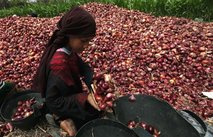 AP story via Vonne Barnett.
AP story via Vonne Barnett.
The basic problem persists:
Families from Pakistan to Argentina to Congo are being battered by surging food prices that are dragging more people into poverty, fueling political tensions and forcing some to give up eating meat, fruit and even tomatoes.
Scraping to afford the next meal is still a grim daily reality in the developing world even though the global food crisis that dominated headlines in 2008 quickly faded in the U.S. and other rich countries.
With food costing up to 70 percent of family income in the poorestcountries, rising prices are squeezing household budgets and threatening to worsen malnutrition, while inflation stays moderate in the United States and Europe. Compounding the problem in many countries: prices hardly fell from their peaks in 2008, when global food prices jumped in part due to a smaller U.S. wheat harvest and demand for crops to use in biofuels.
Majeedan Begum, a Pakistani mother of five, said a bag of flour for bread, the staple of her family's diet, costs three times what it did two years ago in her hometown of Multan. She can no longer afford meat or fruit.
"My domestic budget has been ruined," said Begum, 35.
The U.N. Food and Agriculture Organization's food price index — which includes grains, meat, dairy and other items in 90 countries — was up 22 percent in March from a year earlier though still below 2008 levels. In some Asian markets, rice and wheat prices are 20 to 70 percent above 2008 levels, it says.
Many governments blame dry weather and high fuel costs but critics in countries such as India, Argentina and Egypt say misguided policies are making shortages worse and collusion by suppliers might be pushing up prices.
No single factor explains the inflation gap between developing and developed countries but poorer economies are more vulnerable to an array of problems that can push up prices, and many are cropping up this year.
Farmers with less land and irrigation are hit harder by drought and floods. Civil war and other conflicts can disrupt supplies. Prices in import-dependent economies spike up when the local currency weakens, as Pakistan's rupee has this year.
Costs also have been pushed up by a rebound in global commodity prices, especially for soy destined for Asian consumption. That has prompted a shift in Argentina and elsewhere to produce more for export, which has led to local shortages of beef and other food. The global financial crisis hurt food production in some countries by making it harder for farmers to get credit for seed and supplies.
An old paradigm approach (developed versus developing) hides the underlying reality: the price rises aren't a West-versus-rest dynamic, but a New Core-versus-Gap dynamic. An emerging middle class in the New Core eats better--and more--and that demand for commodities drives up prices for everybody (to the extent that government subsidies are overwhelmed).
Yes, amidst that compelling dynamic, you can cite all the usual suspects in developing and underdeveloped economies, but you're missing the new forest for the usual trees.
Clearest evidence are New Core pillars and rich Arab petrocracies buying up farmland across the Gap. The West isn't doing that.
So understand this as a problem of globalization's success, and stop defining it in old-speak.